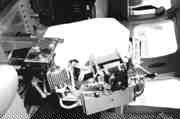Ontario-based Ekwan Technologies is hoping to take a stranglehold on what it believes will be a large emerging market for an airborne system that maps geochemical alteration over large areas. The system uses hyperspectral scanning, a technique that measures the reflectance of the ground much as an airborne gamma-ray spectrometer measures its radioactivity.
Hyperspectral scanning is a new digital twist on a much older technique, infrared spectrometry. It has been known for years that many mineral species absorb characteristic wavelengths of light in the visible and near-infrared spectrum. Lab-bench infrared spectrometers, later joined by hand-held units that could be used in the field, had been successful in making instant mineralogical determinations on drill cores, hand samples and outcrops.
Because clays, particularly, showed characteristic spectral signatures, infrared spectrometry developed most quickly as a way of detecting hydrothermal alteration patterns. Other typical alteration minerals showed useful spectral behaviors too: carbonate minerals absorb strongly in the infrared range, and iron oxides in the visible range.
But to be practical as a reconnaissance tool, hyperspectral scanning had to meet another familiar technology, remote sensing. The first tentative steps came in the mid-1970s.
The Landsat system of the time had sensors that took images in four separate spectral categories — two sensors covering bands in the visible-light spectrum, and two covering bands in the near infrared range. (A third infrared channel was added in later satellite launches.) The most common product for explorationists was the false-colour print, a satellite “photo” whose colours represented the intensity of reflectance in each spectral band the system measured. Strong infrared reflectors — areas of widespread forest cover, for example — were coloured red, giving the novice an unsettling introduction to the task of interpreting the imagery.
The limited number of channels and the relatively coarse resolution of the image marked the technique as a pure reconnaissance tool. Landsat proved useful in regional-scale structural and lithological mapping, but the wide band width the sensors sampled did not indicate changes in bedrock or soil composition. For one thing, it could not tell clays from carbonates, because both groups of minerals had strong absorbances in a single Landsat sensor band.
To do that, the interpreter needed finer divisions of the visible and infrared spectrum, and the computer systems of the time weren’t up to it. When processors and storage systems caught up with the sensors’ ability to discriminate between reflectance wavelengths, “hyperspectral scanning” — the marriage of remote sensing and spectrometry — became practical.
Unlike the older satellite-imagery systems, hyperspectral scanning measures the reflectance of the earth’s surface in narrow wavelength channels — as though a bank of cameras, each with a lens filter that would admit only a particular hue, were taking simultaneous pictures of the earth’s surface.
It didn’t even need to be the earth’s surface — among the first applications were the Mars Global Surveyor, Galileo, and Cassini spacecraft missions to Mars, Jupiter and Saturn. The mid-1990s space probes used systems that split the infrared spectrum (or in Cassini’s case, both the visible and the near-infrared) into 300 to 400 channels. But being run from a satellite platform, they lacked close-detail resolution; images generally could pick out features around 100 metres in size, a resolution comparable to the earlier Landsat photos.
The system Ekwan now has in use splits the visible-light and near-infrared spectrum — wavelengths from 400 to 2,500 nm — into 366 channels of information. Mounted in a light plane, it resolves images into pixels less than 1 metre wide. The tight resolution of the ground and of the spectrum the system is measuring makes for an immense data set — 366,000 separate measurements in a line-kilometre of survey.
The on-board computing capacity has additional channels to collect geophysical data, so that magnetic, electromagnetic and radiometric surveys, each with their own sensors, can be run from the same platform and integrated with the spectral information into a single data set.
The result is a false-colour image with a difference: by combining the results from specific narrow-reflectance channels, it can be tailored to map the intensity of reflectance characteristic of a single mineral species.
Obviously, the success of a hyperspectral scanning system will depend greatly on the level of detail the ground itself shows or hides. Tests in the Chilean desert west of Calama, done by
Ekwan hopes to vault past this problem with its tighter spatial resolution and finer tuning of the spectrum. The unit also flies at a 100-metre altitude, much lower than the 3,000-metre flying altitude of other hyperspectral scanners. The lower flight improves the resolution and permits the system to fly in overcast weather. Varying light conditions, which control the intensity of light and infrared radiation that gets back to the sensors, can be monitored and calibrated by repeat flights over a plain-white ground target during the survey day.
The company’s first system is flying now, and Ekwan has plans for a second system collecting data from 272 channels, with a resolution of 0.2 metre on the ground.


Be the first to comment on "Geochemistry from a hundred metres up"